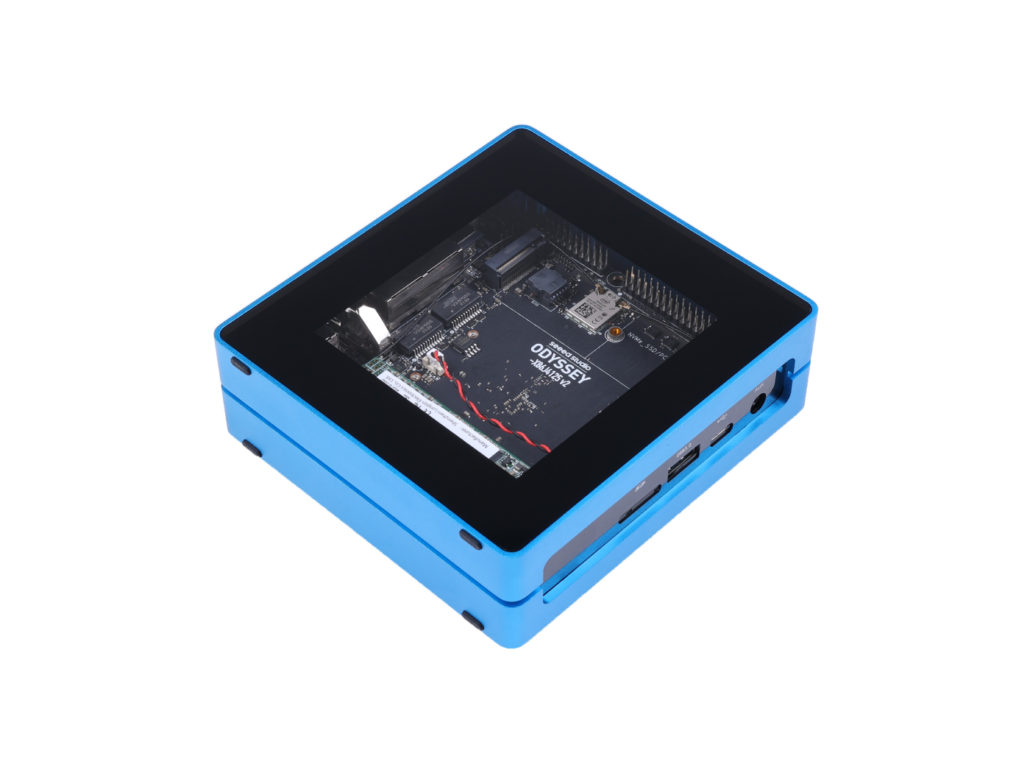Build an NVR camera system with Frigate! Monitor your security cameras with locally processed AI

Today we wanna share a super cool open-source project to help you build up an NVR system with AI detection, and everything will be processed locally!
Frigate is a complete open source and local NVR designed for Home Assistant with AI-powered object detection(Kudos sents!?). It uses OpenCV and Tensorflow to perform real-time object detection locally for IP cameras. Frigate brings a rich set of features including video recording, re-streaming, motion detection, and supports multiprocessing. Leveraging Google Coral TPU USB accelerator for 100+ FPS object detection, you can run advanced AI analysis with an Odyssey Blue, an Intel Celeron J4125 powered powerful Linux mini PC, to determine if the motion is actually a person, car, or any object you want to detect. With Frigate’s local processing, there is no need cloud fee anymore for storing your personal camera footage and the analysis record.
Why Frigate?
Traditional NVRs have higher false positive rates and can require hours of fine-tuning to reduce false positive rates because they rely on simple motion detection. Leveraging Google Coral TPU(USB accelerator and M.2 Module) for object detection, you can run advanced AI analysis with a mini PC to determine if the motion is actually a person, car, or any object you want to detect. With Frigate’s local processing, there is no need cloud fee any more for storing your personal camera footage and the analysis record.
All processing locally
No need to pay for sending your personal camera footage to the cloud for analysis.
Never miss a frame of detection
Frigate can run over 100 object detections per second, so it never misses a frame. Frigate tracks objects in real-time and can determine the exact time a person starts walking up your front steps or a car enters your driveway.
Design for Home Assistant, seamless integrate into your smart home system
Make your home eyesight by integrating object detection into Home Assistant, OpenHab, NodeRed, or anything with MQTT support. Frigate integrates directly into Home Assistant’s media browser, provides a low-latency camera entity, and exposes real-time sensors and switches to power automation and notifications to your heart’s content.
Easily check the target camera
Dynamically renders cameras with active detection by Birdseye view.
What hardware do you need for Frigate?
- Local Server
- Camera
- AI accelerator
Frigate provides detailed installation and configuration on their docs.
You can also follow up on this step-by-step guide and install Home Assistant and Frigate with the Odyssey X86J4125 series.
Edge Server
There is a also discussion on Reddit ”What’s the best hardware for Frigate using a Coral m.2 instead the USB version?”
Seeed Odyssey Blue J4125 wins!
Odyssey Blue: J4125 v2 – Mini PC with 128GB M.2 SATA, Linux and RP2040 Core, dual 2.5 Gigabit Ethernet NICs
Odyssey Blue J4125 V2 allows you to simply build Edge Computing applications with powerful CPUs and rich communication interfaces. The Odyssey Blue J4125, based on Intel Celeron J4125, is a Quad-Core 2.0GHz CPU that bursts up to 2.7GHz. There is also an onboard ATSAMD21 Core, an ARM Cortex-M0+ MCU that allows you to program Arduino on the x86 platform.

You can also use Raspberry Pi 4 with Frigate. We recommend Raspberry Pi CM4-based reTerminal and Dual Gigabit Ethernet NICs. You can also use OpenWRT for Home Assistant projects.
AI accelerator
Frigate supports Google Coral, USB acceralator or M.2 B+M PCIe accelerator card. We know it’e been a while out of stock. Please subscribe to the product back-in-stock notification and our Edge AI updates!
Camera
You can use any IP camera. Blake Blackshear, the author of the Frigate project also recommends Dahua, Hikvision, and Amcrest in that order.
“Dahua edges out Hikvision because they are easier to find and order, not because they are better cameras. I personally use Dahua cameras because they are easier to purchase directly. In my experience Dahua and Hikvision both have multiple streams with configurable resolutions and frame rates and rock solid streams. They also both have models with large sensors well known for excellent image quality at night. Not all the models are equal. Larger sensors are better than higher resolutions; especially at night. Amcrest is the fallback recommendation because they are rebranded Dahuas. They are rebranding the lower end models with smaller sensors or less configuration options.” — Blake Blackshear
What is Home Assistant?
Home Assistant is an excellent platform tool for building smart spaces. It is a mature and complete Python-based smart home system with high device support, including Automation, Group, and UI customization (Theme), etc., and other highly customizable settings. Also implement Siri control of the device. Based on HomeAssistant, you can easily connect various external devices (smart devices, cameras, emails, short messages, cloud services, etc., there are nearly a thousand mature connectable components), and automatically link these external devices manually or according to your own needs. Build an arbitrary smart space.
Also, check out Everything Smart Home and Home Automation Guy’s YouTube video explaining how to use Frigate NVR with Home Assistant!
What is Home Assistant?
Home Assistant is a free and open-source software for home automation that is designed to be the central control system for smart home devices. It can be accessed via a web-based user interface, via companion apps for Android and iOS, or using voice commands via a supported virtual assistant like Google Assistant or Amazon Alexa.
Home assistant enables the local control of smart home devices, offering better security, greater reliability, and more flexibility than many cloud-connected devices.
More Home Assistant projects working with Seeed hardware:
- Smart Home with Home Assistant on OpenWrt
- How to use Home Assistant with a Seeed Mini Router (Installation, Configuration and Control)
Start Frigate with Odyssey Blue J4125 and let us any other cool functions you might want to build!
Any other cool open source project are you working with? Let us know and explore together!